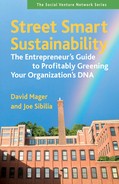Resource B
Audit Protocol
What follows is a protocol for performing your sustainability audit.
I. Policy
A. Do you have a sustainability policy statement?
B. Has it been approved by senior management?
C. Is it in the employee handbook? And visible tocustomers? Vendors? Stockholders? Other stakeholders (e.g., the community)?
II. Sustainability Aspects
A. Does the enterprise have a procedure to determine the company’s key aspects and impacts on sustainability? (See chapter 4 on metrics.)
B. Does the sustainability policy address these issues?
III. Legal and Other Requirements
A. Does the company have a procedure for knowing what federal, state, and local laws it must comply with?
B. Is the company in compliance with those laws?
C. Has the company voluntarily committed to comply with any other rules or principles (CERES, Natural Step, Trade Association of Ethical Standards, living wage, fair trade, organic, etc.)?
D. Is the company in compliance with these other rules it volunteered to comply with?
IV. Environmental Management System
A. Does the company have an environmental management system (EMS) or environmental contract?
B. Does it set objectives and goals for each of the areas the company is targeting with performance dates?
C. Is there a code of ethical conduct for senior management?
D. Does the EMS delineate responsible personnel and specify to whom they report?
E. Is there a procedure for training employees in their responsibilities regarding the company’s sustainability plans, for checking their compliance and competence, and for rewarding their performance?
F. Is the EMS well documented? And is there a procedure for documentation revision and for removing out-of-date documentation?
G. Has the organization assigned sufficient management, employees, and other resources to implement the EMS?
H. Is there a procedure for dealing with nonconformance with the EMS, for making corrections, and for preventing nonconformance?
I. Is there a procedure for anticipating, preventing, and dealing with emergencies, including regulated emergencies (oil spill), natural disasters (fire, flood, and swine flu outbreak), or business emer-gencies (interruption of incoming supply, brown-out, etc.)
J. Is there a procedure for communicating the results of this audit internally and externally?
K. Does the EMS adequately deal with monitoring and measurement of EMS parameters and keeping EMS records? (For more details, see chapter 4.)
V. Environmental Attributes
A. Energy Use and Conservation—Details on calculating energy use are covered in chapter 7.
B. Water Use and Conservation—How much water do you use in total? For incorporation into products? For buildings? For grounds? For manufacturing? For heating and cooling? How much gray water do you use?
C. Material Use and Conservation—Make a manifest and quantify all the items you buy, inventory, and use. If the task seems daunting, make a list of the top ten items you buy, inventory, and use. Include the number of units and the weight and volume of each unit. A more detailed assessment called an input/output mass balance analysis is covered in chapter 4.
D. Releases to Water—How much sewage does your business produce per year? Do you pay for metered sewage services, and if so, what is your total suspended solids (TSS), biological oxygen demand (BOD), chemical oxygen demand (COD), total oxygen demand (TOD), grease/oil, and total Kjehdahl nitrogen (TKN) per year? Is any on-site water treatment conducted? Quantify its impact on releases. The Toxic Release Inventory (TRI) requires that companies that produce over a certain amount of toxic waste report what their releases to water and emissions to air are. Quantify your releases to water of each compound you use and dispose of. List the amount of nutrient or sediment credits you purchase (or produce); it is worth knowing that the mandatory reporting of releases of toxic chemicals is the single greatest factor in their reduced use.
E. Emissions to Air—Quantify your releases to air of regulated and nonregulated substances. Your emissions to air of carbon dioxide are examined in chapter 8. Quantify how many environmental credits (VOCs, NOx, SOx, etc.) you use or produce.
F. Solids—What is the weight of material you reuse each year? What is the weight of material you recycle each year? What is the weight of material you dispose of each year? What is your percent diversion (weight of material used and recycled divided by weight of material used, recycled, and thrown out). Use a random number generator to pick a day and container on which to do a “dump dive” and quantify what is in your waste.
